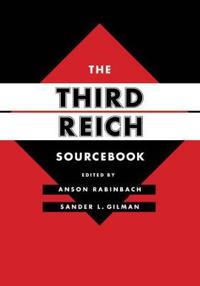Echo of the Reich (Pocket)
avJames Becker
ISBN: 9780451238290 - UTGIVEN: 201210A deadly weapon uncovered...
A decades-old conspiracy...
A race to save a city...
Berlin, 1936: When African-American Jesse Owens wins four gold medals in the Olympic Games, Hitler refuses to place the medals around Owens's neck and vows to develop a means of wiping "inferior" races fro[...]After the Reich (Häftad)
avGiles MacDonogh
ISBN: 9780465003389 - UTGIVEN: 200902When Hitlers government collapsed in 1945, Germany was immediately divided up under the control of the Allied Powers and the Soviets. A nation in tatters, in many places literally flattened by bombs, was suddenly subjected to brutal occupation by vengeful victors. According to recent estimates, as[...]
Web Engineering: The Discipline of Systematic Development of Web Applicatio (Häftad)
avEditor:Gerti Kappel, Co-Editor:Birgit Pröll, Co-ed Reich
ISBN: 9780470015544 - UTGIVEN: 2006-07-31Media Rules!: Mastering Today's Technology to Connect With and Keep Your Au (Inbunden)
avBrian Reich, Dan Solomon
ISBN: 9780470108888 - UTGIVEN: 2008-01-31Shift & Reset: Strategies for Addressing Serious Issues in a Connected Soci (Häftad)
avBrian Reich, Jean Case
ISBN: 9780470942673 - UTGIVEN: 2011-09-30Teaches the nonprofit/social change/philanthropy/cause community how to take advantage of changing technologies and communication ecosystem that exist in our connected society. This title addresses the challenges facing the nonprofit/social change/philanthropy/cause community.[...]
Marketing Management for the Hospitality Industry: A Strategic Approach (Inbunden)
avAllen Z. Reich
ISBN: 9780471310129 - UTGIVEN: 1997-04-30The only advanced marketing textbook specifically focused on the hospitality industry... The time when you could run a hospitality business with nothing but a friendly smile and a strong work ethic has passed. Dining, lodging, and entertaining habits are changing rapidly as the information age rev[...]
Handbook of Reagents for Organic Synthesis, Acidic and Basic Reagents , (Inbunden)
avHans J. Reich
ISBN: 9780471979258 - UTGIVEN: 1999-04-30Foreign Policy of the Third Reich, The (Övrig)
avKlaus Hildebrand
ISBN: 9780520025288 - UTGIVEN: 1973-12-17In this short outline history of Hitler's foreign policy, Professor Hildebrand contends that the National Socialist Party achieved popularity largely because it integrated all the political, economic and socio-political expectations prevailing in Germany since Bismarck. Thus, foreign policy under Hi[...]
The Third Reich Sourcebook (Inbunden)
avAnson (EDT) Rabinbach, Sander L. (EDT) Gilman, Anson (EDT) Rabinbach
ISBN: 9780520208674 - UTGIVEN: 2013-07No documentation of National Socialism can be undertaken without the explicit recognition that the "German Renaissance" promised by the Nazis culminated in unprecedented horror - World War II and the genocide of European Jewry. With "The Third Reich Sourcebook", editors Anson Rabinbach and Sander L.[...]
Munich and Memory: Architecture, Monuments, and the Legacy of the Third Reich (Övrig)
avGavriel David Rosenfeld
ISBN: 9780520219106 - UTGIVEN: 2000-04-18Munich, notorious in recent history as the capital of the Nazi movement, is the site of Gavriel Rosenfeld's stimulating inquiry into the German collective memory of the Third Reich. Rosenfeld shows, with the aid of a wealth of photographs, how the city's urban form developed after 1945 in direct ref[...]
A Concise History of the Third Reich (Häftad)
avWolfgang Benz
ISBN: 9780520253834 - UTGIVEN: 200602This well-illustrated, highly accessible book at last gives general readers and students a compact, yet comprehensive and authoritative history of the twelve years of the Third Reich - from political takeover of January 30, 1933 to the German capitulation of May 1945. Originally published to rave re[...]
Hidden Truth: Young Men Navigating Lives in and Out of Juvenile Prison (Övrig)
avAdam Reich
ISBN: 9780520262669 - UTGIVEN: 2010-07-15"Hidden Truth" takes the reader inside a Rhode Island juvenile prison to explore broader questions of how poor, disenfranchised young men come to terms with masculinity and identity. Adam D. Reich, who worked with inmates to produce a newspaper, writes vividly and memorably about the young men he ca[...]
Hidden Truth: Young Men Navigating Lives in and Out of Juvenile Prison (Övrig)
avAdam Reich
ISBN: 9780520262676 - UTGIVEN: 2010-07-15"Hidden Truth" takes the reader inside a Rhode Island juvenile prison to explore broader questions of how poor, disenfranchised young men come to terms with masculinity and identity. Adam D. Reich, who worked with inmates to produce a newspaper, writes vividly and memorably about the young men he ca[...]
German Voices: Memories of Life During Hitler's Third Reich (Övrig)
avFrederic C. Tubach
ISBN: 9780520269644 - UTGIVEN: 2011-05-02What was it like to grow up German during Hitler's Third Reich? In this extraordinary book, Frederic C. Tubach returns to the country of his roots to interview average Germans who, like him, came of age between 1933 and 1945. Tubach sets their recollections and his own memories into a broad historic[...]
The Third Reich Sourcebook (Pocket)
avAnson (EDT) Rabinbach, Sander L. (EDT) Gilman, Anson (EDT) Rabinbach
ISBN: 9780520276833 - UTGIVEN: 2013-07No documentation of National Socialism can be undertaken without the explicit recognition that the "German Renaissance" promised by the Nazis culminated in unprecedented horror - World War II and the genocide of European Jewry. With "The Third Reich Sourcebook", editors Anson Rabinbach and Sander L.[...]
The German Army and the Defence of the Reich (Inbunden)
avMatthias Strohn
ISBN: 9780521191999 - UTGIVEN: 201011Historical research on the German army of the interwar period has concentrated on the development of the so-called 'Blitzkrieg'. However, Matthias Strohn shows that for most of the time the German army, restricted by the terms of the Versailles Treaty, was too weak to launch an offensive war or even[...]
The Holy Reich (Pocket)
avRichard Steigmann-Gall
ISBN: 9780521603522 - UTGIVEN: 200407Analyzing the previously unexplored religious views of the Nazi elite, Richard Steigmann-Gall argues against the consensus that Nazism as a whole was either unrelated to Christianity or actively opposed to it. He demonstrates that many participants in the Nazi movement believed that the contours of [...]
Monitoring in Anesthesia and Perioperative Care (Inbunden)
avDavid L. Reich, Ronald A. (EDT) Kahn, Alexander J. C. (EDT) Mittnacht
ISBN: 9780521755986 - UTGIVEN: 2011-08Monitoring in Anesthesia and Perioperative Care is a practical and comprehensive resource documenting the current art and science of perioperative patient monitoring, addressing the systems-based practice issues that drive the highly regulated health care industry of the early twenty-first century. [...]
The Third Reich in the Ivory Tower (Inbunden)
avStephen H. Norwood
ISBN: 9780521762434 - UTGIVEN: 2009-05-01In this disturbing book, Norwood exposes the moral failings of American educators who helped the Nazis improve their image in the West as they intensified their persecution of the Jews and strengthened their armed forces.[...]
Simulating Hamiltonian Dynamics (Inbunden)
avB. Leimkuhler, Sebastian Reich
ISBN: 9780521772907 - UTGIVEN: 200502Geometric integrators are time-stepping methods, designed such that they exactly satisfy conservation laws, symmetries or symplectic properties of a system of differential equations. In this book the authors outline the principles of geometric integration and demonstrate how they can be applied to p[...]
An Artist Against the Third Reich
ISBN: 9780521821384 - UTGIVEN: 2003-03The conflict between National Socialism and Ernst Barlach, one of the most important sculptors of the twentieth century, is an unusual episode in the history of Hitler?s efforts to rid Germany of ?international modernism?. Barlach did not passively accept the confiscation and destruction of his scul[...]
The Holy Reich
ISBN: 9780521823715 - UTGIVEN: 2003-04Steigmann-Gall argues against the consensus that Nazism as a whole was either unrelated to Christianity or actively opposed to it.[...]
The Western Perspective (Inbunden)
avPhilip V. Cannistraro, John J. Reich
ISBN: 9780534610654 - UTGIVEN: 2003-08-28With Info Trac.
The Western Perspective (Pocket)
avPhilip V. Cannistraro, John J. Reich
ISBN: 9780534610661 - UTGIVEN: 2003-08-24Clara Schumann: Piano Virtuoso (Häftad)
avSusanna Reich
ISBN: 9780618551606 - UTGIVEN: 200506This intimate portrait describes the life of German pianist and composer Clara Schumann, who made her professional debut at age nine and devoted her life to music and her family. Illustrated with black-and-white archival photos.[...]


























